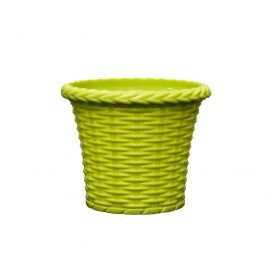African Mask Plant (Alocasia)
₹499.00 Original price was: ₹499.00.₹350.00Current price is: ₹350.00.
African Mask Plant is an attractive foliage plant and houseplant. This plant is mainly grown for its heavily-veined, dark green heart-shaped leaves. It’s also called Elephant ear plant. It is a shade loving plant, thus it is apt for tabletop, Be room bathroom, shaded balcony etc.
- Easy to care
- Need Less water
- Attractive Foliage
- Apt for Bedroom, Bathroom, Shaded Balcony, Staircase side etc.
Plant with 5″ pot ( Pot colour may vary)
Plant Height: Upto 1 ft
African Mask Plant is an attractive foliage plant and houseplant. This plant is mainly grown for its heavily-veined, dark green leaves. The stunning, veined leaves are very large, glossy, heart-shaped with wavy edges. This evergreen plant belongs to Araceae Family. The striking big green leaves make a big impact. Even though it has Africa in its name, Alocasia does not come from Africa at all. It gets its name from the resemblance to the hand-carved ceremonial masks found in Africa. This plant actually hails from South Asia.
Its unique foliage makes it an interesting houseplant and even more interesting in a landscape. These plants have lovely foliage that can look especially stunning when the light shines through the smaller leaves. This plant needs extra care and attention.
Gifting a plant is always a great idea as they are good for health and the environment. More than that, it is always a pleasure to see your gifted plant is growing. If you too have a great idea of gifting a plant, Indoor Plants, especially Alocasia is a good choice. These plants not only helps to create a healthy greenish environment but also helps to create a lively ambience at home. This plant adds a classy greenish touch to your home decor. Go green and Gift a plant. Let us build a better world for the generations to come.
PLANT DETAILS
Scientific Name: Alocasia x mortfontanensis André
Common Names: African Mask, Elephant’s Ear Plant
Synonyms: Alocasialongiloba x Alocasia sanderiana hybrid, Alocasia x amazonica
Family: Araceae
Native Distribution: South East Asia
Benefit: Ornamental Foliage
African Mask Plant Care
- Light: Bright but indirect sunlight, Alocasia tolerates both sun and shade, but it performs best when planted in partially shaded garden beds
- Soil: Use an organic well-aerated loose soil that contains a good amount of peat moss. If the soil seems a little heavy, add some builder’s sand or perlite.
- Water: Allow the top 2″- 3″ of soil to dry out before watering, and try to keep the soil evenly moist. Over-watering, wet leaves, and soggy soil make an Alocasia plant susceptible to a variety of serious fungal infections. Check the soil frequently until you are sure of the plant’s watering needs. Alocasia plants require less water during the winter when it’s dormant.
- Temperature: 60°-80°F (15.6°-26.7°C) These plants becomes dormant with prolonged exposure to temperatures below 60°F(15.6° and may drop all of their leaves.
- Fertilizer: You can use a diluted liquid fertilizer to feed your around once a month as long as it’s growing. Stop feeding completely during the winter months or if the plant is dormant.
- Propagation: Plant Division is the best way to propagate an Alocasia.
- Toxicity: Toxic to Pets
- Pruning: Quickly remove any yellow leaves or those that develop brown or black spots from an Alocasia plant as that may be a sign of a fungal disease.
Life Stage
Plant Division: Angiosperms (Flowering Seed Plants) (Monocotyledon)
Lifespan: Perennial
Mode of Nutrition: Autotrophic
Plant Shape: Shrubby
Plant Size: Maximum height 0.6 m to 1.2 m, maximum spread 0.3 to 0.5 m.
Floral (Angiosperm)
Flower Colours: Cream / Off-White, White
Flowering Habit: Polycarpic
| color | White, Dark Green |
|---|
Be the first to review “African Mask Plant (Alocasia)” Cancel reply
You must be logged in to post a review.
This site uses Akismet to reduce spam. Learn how your comment data is processed.
You may also like…
Related products
Ceramic Pots
Plastic Fancy Pots



















Reviews
There are no reviews yet.